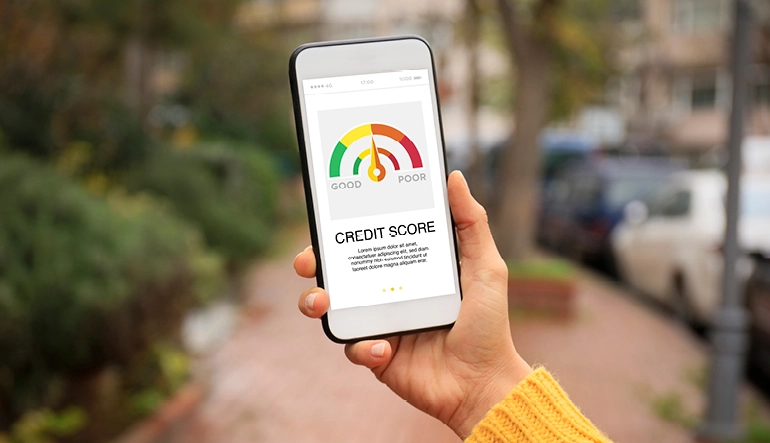
Here are five tips to help jumpstart your credit score:
1. Know Your Current Report and Score
The best way to improve something is to know your starting point and where you are in the beginning and then continue to track it. All consumers have access to one free credit report per year from annualcreditreport.com as well as the three credit reporting agencies; Equifax, Experian and Transunion. This is just the report and you will have to pay a bit extra to see your score. SDCCU primary members with an active loan can view their FICO® Score in online banking. Just log into online banking, click Self Service and View FICO Score under Account Services. If you do not have an SDCCU loan, you might check out other providers that offer the score as well, but just be aware that some of these are companies that provide an inflated simulated credit score, and it can often be different than the score lenders will see. Knowing your score now will give you the baseline of where you are and help you set a realistic goal of improving it. The New Year is a great time to start to set the timeline of what kind of increase you’d like to see by year-end too.
2. Understand Your Credit Risks
Most credit reports also provide a listing or callout of your credit risks. They might be something like, “balances high in comparison to credit limit” or “number of trade lines higher than average,” but there are more than 300 credit risks you can have. Credit utilization rate accounts for the largest percentage of your score at 30% so this plays the largest impact on your score.¹ Knowing your risks will help you narrow in on what you need to improve. For example, if the balances are too high in comparison to your credit limits, then you know that paying down those balances is important. You also don’t want to close or lower any of your credit limits, as that could make this risk factor even higher. If the risk is that you have too many credit lines, you might want to focus on paying off any with low balances and closing them along with any lines that have $0 balances. If the credit risk is related to late payments, then you will want to focus on step 3. The credit risks are there to tell you exactly what you need to do to improve your report and score.
3. Pay Your Bills on Time
Late payments can have a big impact to your credit score. Focusing on ensuring all of your payments are received on time, all of the time is very important. Even if you have low balances and very little debt, late payments can still hurt your score. If you are forgetful or have a hard time sending in payments, autopay or setting up recurring payments may be your best bet. Set them and then forget it and ensure your payments are made on time every time. If this is hard due to fluctuating pay schedules, just set up the minimum and then send additional payments when you can. Most importantly, ensure you are aware of your loan due dates, grace periods, if any, and the deadline for fees and dates they report to the credit bureaus. If you ever have issues, calling the lender to let them know your intent to pay and circumstances is better than just skipping the payment altogether. The lender may even offer skip payments, payment deferrals or other options to help you if it is an abnormal occurrence.
4. Look Into Alternative Loan Options
SDCCU and other lenders offer secured credit cards or loans. These are usually loans that are secured by your own funds in a savings account so they don’t require the same qualifications as standard unsecured credit. So whenever you use your card or loan and then pay it back, you are essentially paying yourself back and also building credit in a safe and responsible manner. These are great for first time borrowers, those with minimal credit and those trying to rebuild their credit history.
5. Monitor Your Progress
Keep track of your credit-building efforts by requesting your free annual credit report and reviewing it at least once a year. If you are making progress and want to do it more often, look into joining one of the monitoring solutions from the credit agencies or other options. Not only will this help you monitor your credit report and score, but being aware of what is on your credit report can help you watch for any discrepancies that may happen along the way, and alert you to any suspicious activity and even identity theft, which can have a negative impact on your credit.
Your credit score is a reflection of your reported credit history at one moment in time. It may sound counterintuitive that you need credit to get credit, but most people don’t realize that you can’t improve your credit score without carrying debt. In fact, if you’re looking for ways to increase your credit overnight, your best option is paying down high balances on revolving lines-of-credit like credit cards or a home equity line of credit.
If you are ready to jumpstart your credit score, and would like to discuss the best options for your financial situation, contact us to help you find the best program to fit your current financial needs. SDCCU customers also have access to free financial resources and counseling from our financial fitness partner, Balance, at sdccu.com/balance.
Visit our Financial Knowledge Blog to learn more tips on setting up a solid financial future or join us for free Financial Wellness Wednesdays webinars.
₁ Your credit utilization rate accounts for approximately 30% of your credit score! https://www.experian.com/blogs/ask-experian/credit-education/score-basics/credit-utilization-rate/



